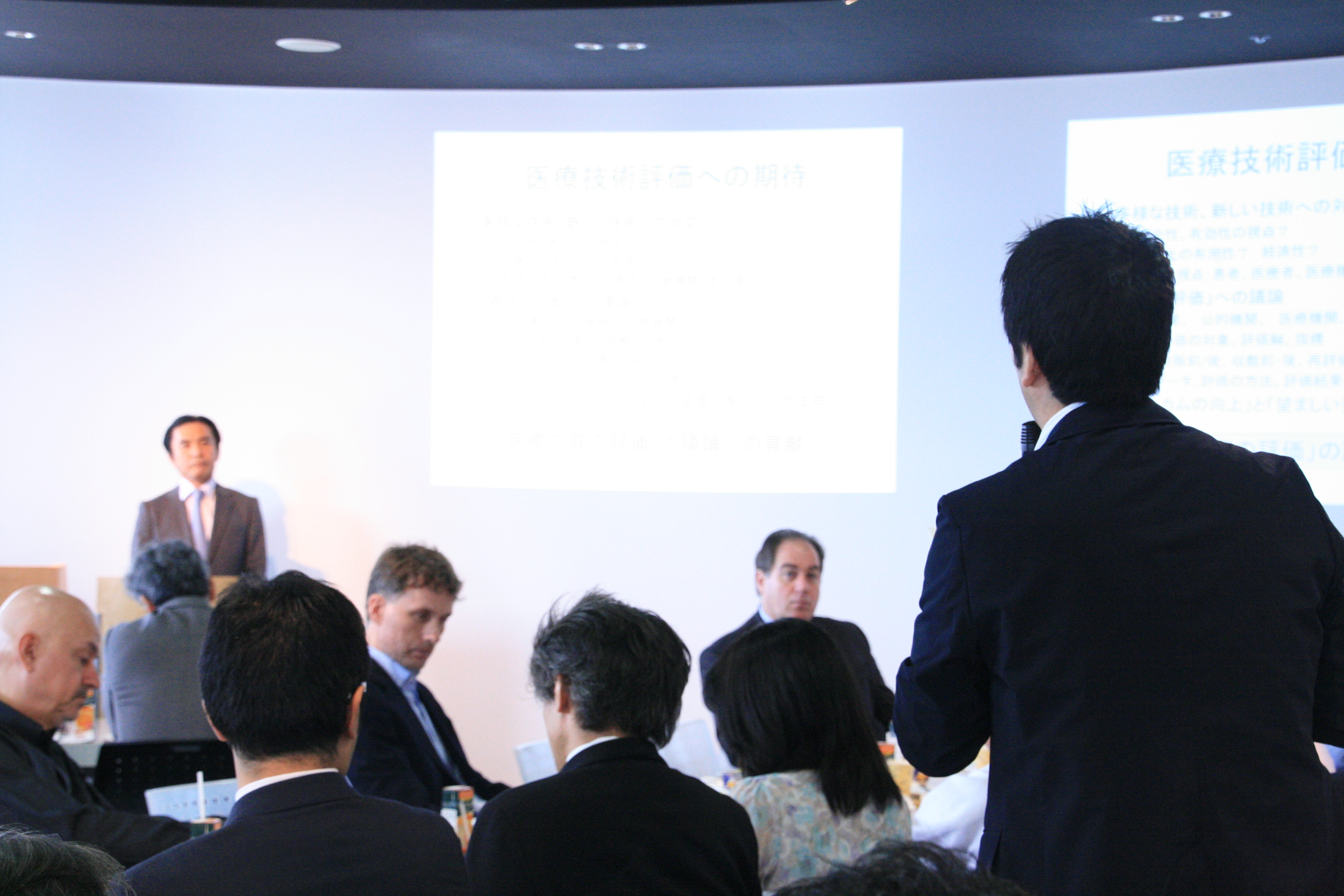[Event Report] The 59th Breakfast Meeting:Technology Innovation and HTA
date : 10/28/2016
Tags: Future of the Health Care System, HGPI Seminar, Innovation and Sustainability
The theme for this breakfast meeting was “Technology Innovation and Health Technology Assessments (HTA).” GraSPP Prof. Akio Onishi talked about Japan’s health care system, as well as the future of health policies and how they compare with health systems in other countries.
[ Summary ]
Innovation and health care systems
The period from 1980 to 1990 saw the creation of a foundation for biotechnology, electronics, and materials technology, as well as the development of biogenetic modification techniques (the first human genome analysis was completed in 2000).
This was also when people began to consider ways to adopt new pharmaceuticals and medical technology into health care systems, along with progress in technology.
In the United States, people began to notice the differences between pharmaceuticals and medical technology. Progress was made on the reconsideration of the systems used to evaluate drug safety and efficacy, leading to the passage of the FDA Modernization Act in 1997.
In addition, in terms of medical payments, the Diagnosis Related Group (DRG) system was introduced in 1983 to evaluate medical fees based on the diagnoses given rather than the methods or processes of treatment used.
As a general rule, this system means that payments to hospitals are decided not per medicine, device and procedure, but per diagnosis code.
The difference between pharmaceuticals and medical technology
Pharmaceuticals and health technology have greatly different properties. While pharmaceuticals are developed from “discovered” substances, and then become recognized after being patented, health technology is “developed” and recognized once it shown to have a new structure or mechanisms that allow it to demonstrate new properties and effects and so on. Therefore, new health technology does not always result in a new patent.
The execution of clinical trials is also a big difference here.
With pharmaceuticals, it is usually not difficult to return to a normal treatment even if the clinical trial is stopped, but with implanted health technology, for instance, it is not easy to stop treatment due to the risks associated with removing the health technology from the body.

The health care system in Japan
In Japan, up until the Pharmaceutical Affairs Act and the Pharmaceuticals and Medical Devices Act were amended in 2014, health technology was regulated based on the Pharmaceutical Affairs Act, which reflected thinking about the regulation of pharmaceuticals.
Regulations for regenerative medicine devices were also applied.
In addition, regarding the insurance system, methods for evaluating medical payments, drug costs, and materials prices (including some health technology) have thus far been amended every two years. Some are now saying that medical costs will rise to 1.5 times what they are today over the next ten years due to the aging of society and technological innovations.
A variety of discussion is underway to consider the use of HTA and other systems.
Initiatives and future prospects for health care assessments
In addition to considering how we should evaluated the usefulness of individual technologies and products via HTA, it is also crucial to consider the evaluation of improvements in the quality of medical care brought about by the different ways people use products and technology in the midst of health care frameworks.
We are seeing the start of movement on initiatives for assessment systems that take into account outcomes that can measure this, having set the quality of medical care as the goal for medicine.
I am excited for this trend.
Exhibition date:2016-10-14
Top Research & Recommendations Posts
- [Research Report] Perceptions, Knowledge, Actions and Perspectives of Healthcare Organizations in Japan in Relation to Climate Change and Health: A Cross-Sectional Study (November 13, 2025)
- [Research Report] The 2025 Public Opinion Survey on Healthcare in Japan (March 17, 2025)
- [Policy Recommendations] Developing a National Health and Climate Strategy for Japan (June 26, 2024)
- [Policy Recommendations] Mental Health Project: Recommendations on Three Issues in the Area of Mental Health (July 4, 2025)
- [Announcement] HGPI Endorses the “Belém Health Action Plan” (November 14, 2025)
- [Research Report] The 2023 Public Opinion Survey on Satisfaction in Healthcare in Japan and Healthcare Applications of Generative AI (January 11, 2024)
- [Publication Report] Planetary Health Promotion Project “Issues Facing Planetary Health and the Role of the Health Sector” (May 10, 2023)
- [Announcement] HGPI Joins Global Green and Healthy Hospitals (August 1, 2023)
- [Research Report] Survey of Japanese Physicians Regarding Climate Change and Health (December 3, 2023)
- [Policy Recommendations] Reshaping Japan’s Immunization Policy for Life Course Coverage and Vaccine Equity: Challenges and Prospects for an Era of Prevention and Health Promotion (April 25, 2025)
Featured Posts
-
2025-12-11
[Event Report] Core Components of Universal Health Coverage (UHC): Achieving “Healthcare Without Financial Hardship” in Asia-Pacific and Japan (December 5, 2025)
![[Event Report] Core Components of Universal Health Coverage (UHC): Achieving “Healthcare Without Financial Hardship” in Asia-Pacific and Japan (December 5, 2025)](https://hgpi.org/en/wp-content/uploads/sites/2/HGPI_20251210_Core-Components-of-Universal-Health-CoverageUHC-top.jpg)
-
2025-12-12
[Registration Open] Meaningful Involvement Promotion Project Urgent Symposium “The New Takaichi Administration and Central Social Insurance Medical Council Reform – Ensuring Patients’ Voices are Heard” (January 22, 2026)
![[Registration Open] Meaningful Involvement Promotion Project Urgent Symposium “The New Takaichi Administration and Central Social Insurance Medical Council Reform – Ensuring Patients’ Voices are Heard” (January 22, 2026)](https://hgpi.org/en/wp-content/uploads/sites/2/HGPI_20251208_urgent-symposium-1.png)
-
2025-12-12
[Registration Open] (Webinar) The 140th HGPI Seminar “Early Detection to Reduce COPD Disease Burden: Connecting Clinical Frontiers with Health Policy” (January 27, 2026)
![[Registration Open] (Webinar) The 140th HGPI Seminar “Early Detection to Reduce COPD Disease Burden: Connecting Clinical Frontiers with Health Policy” (January 27, 2026)](https://hgpi.org/en/wp-content/uploads/sites/2/hs140-top.png)




